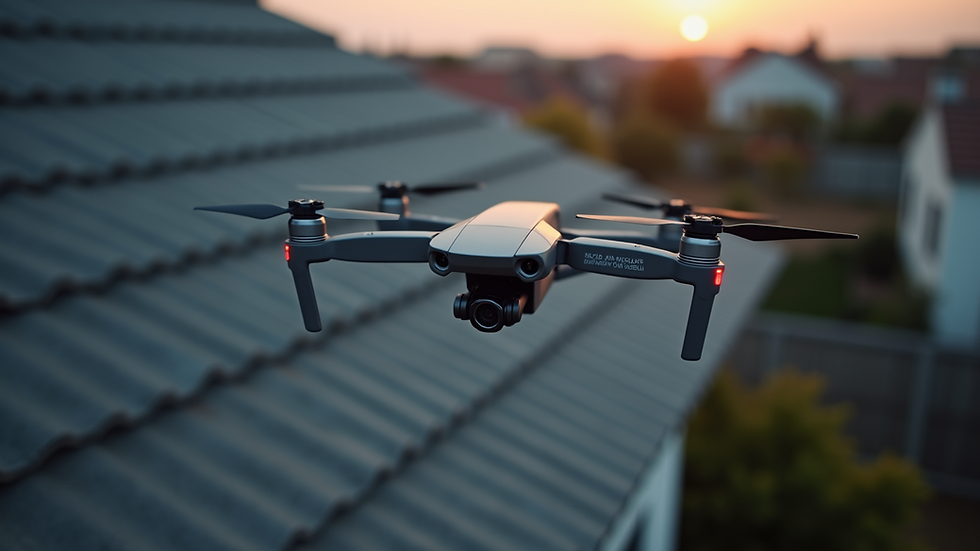Unlock the Benefits of Drone Roof Inspections
- Nathan Schrock

- Sep 22
- 4 min read
When it comes to maintaining a building, the roof is one of the most critical components. Regular inspections are essential to identify damage, wear, or potential issues before they become costly problems. Traditional roof inspections can be time-consuming, risky, and sometimes inaccurate. However, with the rise of technology, drone roof surveys have become a game-changer in the industry. These surveys offer a safer, faster, and more detailed way to assess roofs, providing numerous benefits for property owners, inspectors, and contractors alike.

What Are Drone Roof Surveys and How Do They Work?
Drone roof surveys involve using unmanned aerial vehicles equipped with high-resolution cameras and sensors to capture detailed images and data of a roof’s condition. These drones fly over the property, capturing multiple angles and close-up shots that are difficult or dangerous to obtain manually.
The process typically includes:
Pre-flight planning to map the roof area.
Automated or manual drone flight to capture images.
Data processing to create 3D models or detailed reports.
Analysis of images to detect cracks, leaks, missing shingles, or structural damage.
This technology allows inspectors to gather comprehensive information without physically climbing onto the roof, reducing the risk of accidents and improving efficiency.

Advantages of Using Drone Roof Surveys for Property Maintenance
There are several compelling reasons to choose drone roof surveys over traditional inspection methods:
Safety First
Climbing ladders and walking on roofs can be hazardous, especially on steep or damaged surfaces. Drones eliminate the need for inspectors to physically access the roof, significantly reducing the risk of falls and injuries.
Time and Cost Efficiency
Drone surveys can be completed in a fraction of the time it takes for manual inspections. This speed translates into lower labor costs and faster turnaround for reports, allowing property owners to address issues promptly.
Detailed and Accurate Data
Drones capture high-resolution images and videos that reveal minute details such as small cracks, water pooling, or missing tiles. Advanced sensors can also detect moisture levels or thermal anomalies, providing a more thorough assessment.
Accessibility
Drones can easily access hard-to-reach areas, such as tall buildings, complex roof structures, or roofs surrounded by obstacles. This capability ensures no part of the roof is overlooked.
Environmental Impact
Using drones reduces the need for heavy equipment or scaffolding, minimizing the environmental footprint of inspections.
Is Offering a Free Roof Inspection Soliciting?
Offering a free roof inspection can be a strategic marketing tool for roofing companies and contractors. However, it is important to understand the legal and ethical considerations surrounding this practice.
What Constitutes Soliciting?
Soliciting generally refers to actively seeking business by offering services or products, often in a way that may be considered intrusive or aggressive. Offering a free roof inspection can be seen as soliciting if it is done without prior consent or in violation of local regulations.
Best Practices for Offering Free Inspections
Obtain Permission: Always seek permission before approaching property owners.
Clear Communication: Explain the purpose of the inspection and any potential costs involved if repairs are needed.
Transparency: Be honest about the scope of the free inspection and avoid hidden fees.
Respect Local Laws: Familiarize yourself with local regulations regarding solicitation to avoid legal issues.
By following these guidelines, companies can use free roof inspections as a valuable service to build trust and generate leads without crossing ethical boundaries.

How to Choose the Right Drone Roof Survey Service
Selecting a reliable drone roof survey provider is crucial to ensure accurate results and a smooth inspection process. Here are some tips to help you make the right choice:
Check Credentials and Experience
Look for companies with certified drone pilots and experience in roof inspections. Certifications such as FAA Part 107 (in the US) indicate that the operator is trained and authorized.
Review Technology and Equipment
Ensure the provider uses high-quality drones equipped with advanced cameras and sensors. The ability to produce 3D models or thermal imaging can be a significant advantage.
Ask for Sample Reports
Request examples of previous inspection reports to evaluate the level of detail and clarity.
Consider Turnaround Time
Choose a service that can deliver results promptly, especially if you need to make urgent repair decisions.
Customer Reviews and References
Read reviews and ask for references to gauge customer satisfaction and reliability.
Future Trends in Drone Roof Surveys
The use of drones in roof inspections is evolving rapidly, with new technologies enhancing their capabilities:
Artificial Intelligence (AI): AI algorithms can analyze images to automatically detect damage and prioritize repairs.
Integration with Building Information Modeling (BIM): Combining drone data with BIM systems allows for better planning and maintenance.
Improved Sensors: Advances in thermal, multispectral, and LiDAR sensors provide more comprehensive data.
Regulatory Developments: As drone regulations evolve, expect more streamlined processes for commercial inspections.
These trends will make drone roof surveys even more efficient, accurate, and accessible in the coming years.
Embrace the Future of Roof Inspections Today
Incorporating drone roof inspections into your property maintenance routine offers unmatched benefits. From enhanced safety and cost savings to detailed data and faster service, drones are transforming how roofs are inspected and maintained. Whether you are a property owner, manager, or contractor, embracing this technology can help you stay ahead in maintaining the integrity and value of your buildings.










Comments